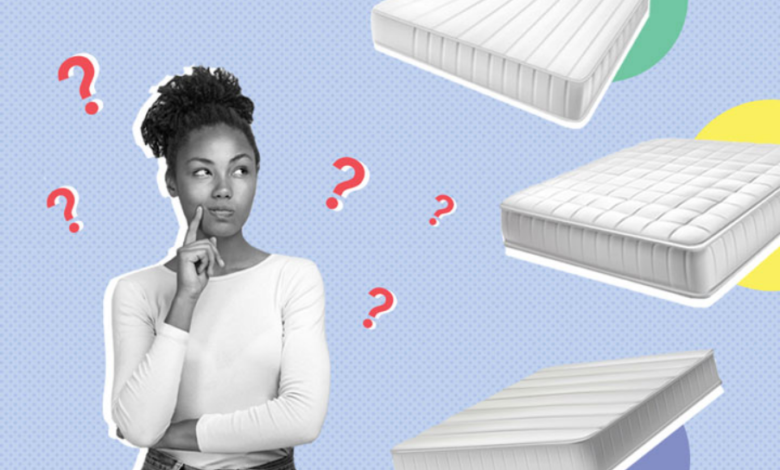How To Choose An Ideal Mattress To Reduce Back Pain

Lower back discomfort can be brought on or worsened by sleeping on an improper mattress. Low back discomfort is exacerbated by bad sleeping posture, which is reinforced by a mattress’ lack of support, as well as by muscle tension and improper spinal alignment.
Sleep comfort is also compromised if a mattress does not suit a person’s personal tastes. Reduced low back discomfort enables the structures in the spine to relax and regenerate during the night genuinely. This is made possible by a mattress offering comfort and back support.
Being in pain and sleep-deprived can impact your emotions, productivity, and health. Poor sleep and persistent back discomfort are two extremely typical bedmates. Various factors can cause poor sleep; if you believe your mattress to be one of them, it may be time to start shopping for a new one.
However, Beds Constitute Significant Investments, So Take The Following Into Account First:
The best mattress doesn’t exist. According to what you are used to, it varies greatly, according to Dr Steven H. Feinsilver, head of the Centre for Sleep Medicine at New York City’s Lenox Hill Hospital. Although we spend nearly a third of our lives sleeping, we still don’t fully understand what the perfect mattress should feel like. That is due to the likelihood that only some types would be ideal for everyone.
In the past, doctors would advise patients to buy hard mattresses. Still, more recent surveys and studies have shown that medium-firm mattresses from Trusted sources are better for spinal alignment, comfort, and sleep quality.
One study from 2011 discovered that when people were given seven beds of varying firmness to test out over a month, there was no agreement on which was the best. Sadly, the subjective nature of terminology like “hard” and “medium firm” can vary widely, so one company’s “medium firm” mattress may not feel at all like another companies. The lack of uniformity in the literature, where readers have looked at it and concluded, “This is the kind of bed you need,” struck Feinsilver as “fairly remarkable.”
Choosing the ideal mattress can be challenging due to the wide range of mattresses available. The Slumber Search team has created the following helpful recommendations to assist people with low back pain in selecting the best mattress for back support and sleep comfort.
1. The ideal mattress should ultimately be determined by personal preference.
No mattress design or kind suits everyone with low back discomfort. The ideal mattress for a particular person allows them to sleep without experiencing pain or stiffness. Low back pain sufferers should pick a comfortable, supportive mattress that allows them to get a decent night’s sleep.
2. Recognise and ask about the mattress’s structural elements.

The support comes from a mattress’ inner springs or coils. The quantity and configuration of coils vary amongst mattresses. The mattress’ top padding is available in a wide range of thicknesses. The average mattress depth ranges from 7 to 18 inches. Individual tastes should be considered while deciding on the number of coils, kind of padding, and mattress depth.
3. Buy a mattress that supports your back.
A good mattress ought to support the spine’s normal curvature and alignment. Additionally, the correct amount of back support aids the patient in avoiding morning muscular discomfort. Despite a shortage of clinical data, a study discovered that medium-firm mattresses typically offer more excellent back pain alleviation than firm mattresses.
4. Strike a balance between comfort and back support.

Overall comfort while lying on the mattress is as crucial as adequate back support. A mattress that is overly firm while you sleep might lead to pressure point aches and pains. Since a medium-firm mattress allows the shoulder and hips to sink in somewhat, it may be more comfortable. For more comfort, patients who want a firmer mattress for back support should get one with more padding.
5. Recognise when a new mattress is needed.
It’s probably time to get a new mattress if your old one is uncomfortable or has a noticeable sag in the middle. A new mattress is still required; placing boards under a sagging mattress will only temporarily prevent it from drooping in the centre.
Mattresses And Back Pain

We should be aware of the connection between beds and back discomfort, even though there isn’t a solid consensus on what makes the ideal mattress. Not as much as you may believe. “Choosing a mattress might be challenging. According to Kevin M. Cerrone, DPT, director of Rehabilitation & Orthopaedic Services at Northwell Health’s Huntington Hospital in Huntington, New York, a mattress shouldn’t be too soft or hard.
Once more, studies suggest that mattresses with medium firmness are often better for lower back discomfort. Reliable Source. According to a 2014 Canadian study, there is “limited conclusive evidence” that different mattress types can alleviate neck and back discomfort, with hard mattresses being the least effective.
Conclusion
Although recent studies have revealed a “medium firm” mattress may help treat lower back discomfort, the scientific community hasn’t primarily agreed on what makes the optimum mattress. The subjective nature of mattress firmness means that it varies from one manufacturer to the next.
Your personal preferences and concepts of comfort should guide any potential mattress choice. To relieve pain before investing in a new mattress, attempt to sleep more comfortably at night. If you must get a new mattress, test it out as thoroughly as you can and return it if it doesn’t reduce your discomfort or enhance your sleep.
A new mattress should be moved every six months to ensure it is worn evenly and to help maintain its quality. This entails regularly flipping the mattress lengthwise and rotating it 180 degrees. The Better Sleep Council warns against using a box spring or foundation that is not intended to support a mattress because doing so could shorten the life of the new mattress.



